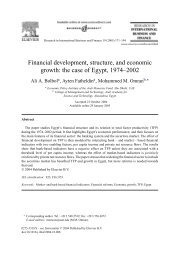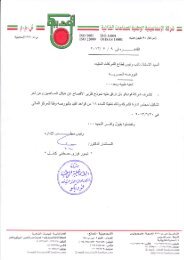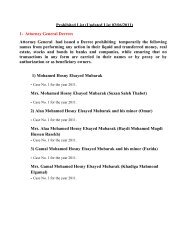Does the inflation rate affect the performance of the stock market ...
Does the inflation rate affect the performance of the stock market ...
Does the inflation rate affect the performance of the stock market ...
Create successful ePaper yourself
Turn your PDF publications into a flip-book with our unique Google optimized e-Paper software.
274<br />
( )<br />
M. Omran, J. Pointon Emerging Markets Reiew 2 2001 263279<br />
In conclusion, <strong>the</strong> results indicated that <strong>the</strong> <strong>inflation</strong> <strong>rate</strong> has a significant<br />
impact on <strong>the</strong> <strong>market</strong> activity in Egypt as all <strong>the</strong> five variables indicated a<br />
significant negative long-run relationship. As well, <strong>the</strong> <strong>inflation</strong> <strong>rate</strong> seems to have<br />
a significant short-run relationship with all <strong>market</strong> activity variables except for <strong>the</strong><br />
number <strong>of</strong> traded companies. In all cases, <strong>the</strong> overall fit <strong>of</strong> <strong>the</strong> selected <strong>inflation</strong><br />
<strong>rate</strong> models <strong>of</strong> <strong>market</strong> activity was good with R 2 ranging from 0.57 to 0.82.<br />
Therefore, <strong>the</strong> hypo<strong>the</strong>sis, which stated that <strong>the</strong> <strong>market</strong> activity increases as <strong>the</strong><br />
<strong>inflation</strong> <strong>rate</strong> decreases, cannot be rejected, implying a negative relationship<br />
between <strong>the</strong> variables.<br />
6.2. Modeling <strong>the</strong> impact <strong>of</strong> <strong>the</strong> <strong>inflation</strong> <strong>rate</strong> upon <strong>market</strong> liquidity through error<br />
correction models<br />
Since <strong>the</strong> results from <strong>the</strong> ADF unit root tests indicated that <strong>the</strong> <strong>inflation</strong> <strong>rate</strong><br />
and <strong>the</strong> <strong>market</strong> liquidity variables were shown to be integ<strong>rate</strong>d <strong>of</strong> <strong>the</strong> same order,<br />
that is, <strong>the</strong>se variables are integ<strong>rate</strong>d <strong>of</strong> order 1, static long-run regressions were<br />
performed using ordinary least squares Ž OLS .. The outputs <strong>of</strong> this analysis are<br />
given in Table 4, which summarizes <strong>the</strong> results <strong>of</strong> this test.<br />
The residuals from <strong>the</strong> static long-run equations as described in Table 4 were<br />
integ<strong>rate</strong>d <strong>of</strong> order zero, suggesting that <strong>the</strong> variables in each bivariate relationship<br />
are co-integ<strong>rate</strong>d, that is, <strong>the</strong>re is a long-run relationship between <strong>the</strong>se variables,<br />
which is negative as identified in <strong>the</strong> regressions. However, EC models can<br />
represent <strong>the</strong> co-integration relationship between <strong>the</strong> variables explaining both a<br />
long- and short-run relationship simultaneously. Table 5 shows <strong>the</strong> final model for<br />
each lag.<br />
The <strong>inflation</strong> <strong>rate</strong> models, which targeted <strong>market</strong> liquidity as <strong>the</strong> dependent<br />
variable, contain significant ECMs at <strong>the</strong> 1% level.<br />
The <strong>inflation</strong> <strong>rate</strong> model <strong>of</strong> <strong>the</strong> relationship with <strong>the</strong> total value traded to <strong>market</strong><br />
capitalization confirmed a co-integration relationship between <strong>the</strong> variables as <strong>the</strong><br />
ECM was significant with a lag <strong>of</strong> 1 for <strong>the</strong> differenced autoregressive variable and<br />
a lag <strong>of</strong> 3 for <strong>the</strong> differenced <strong>inflation</strong> <strong>rate</strong>. However, <strong>the</strong> coefficient <strong>of</strong> <strong>the</strong><br />
Table 4<br />
Static long-run models for <strong>the</strong> impact <strong>of</strong> <strong>the</strong> <strong>inflation</strong> <strong>rate</strong> upon <strong>market</strong> liquidity variables<br />
2<br />
Variables Coefficient S.E. t-Prob. F-Prob. R<br />
y Constant 1.4716 0.36802 0.0010<br />
6,t<br />
Inflation 7.7040 1.8454 0.0007 0.0007 0.52<br />
y Constant 1.6273 0.20597 0.0000<br />
7,t<br />
Inflation 8.8736 1.0328 0.0000 0.0000 0.822<br />
Notes: y total value traded to <strong>market</strong> capitalization; and y volume <strong>of</strong> shares traded to volume<br />
6 7<br />
<strong>of</strong> shares listed.








